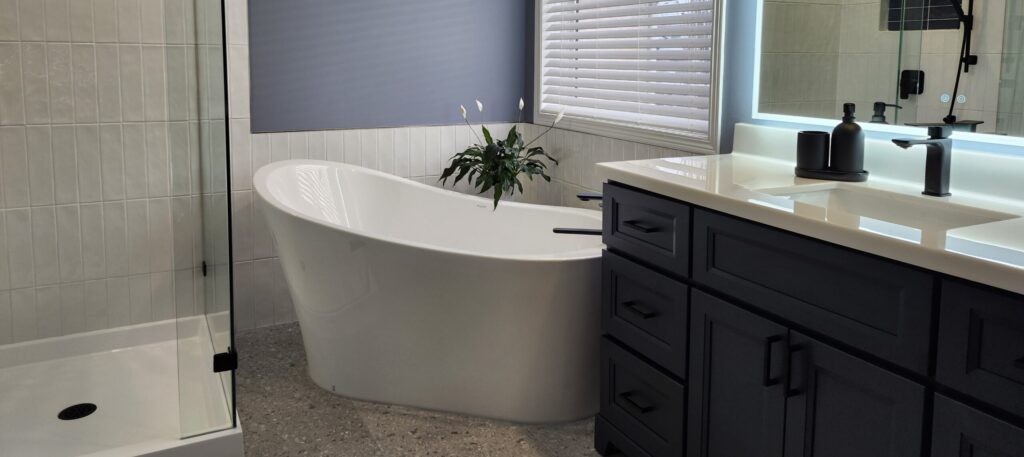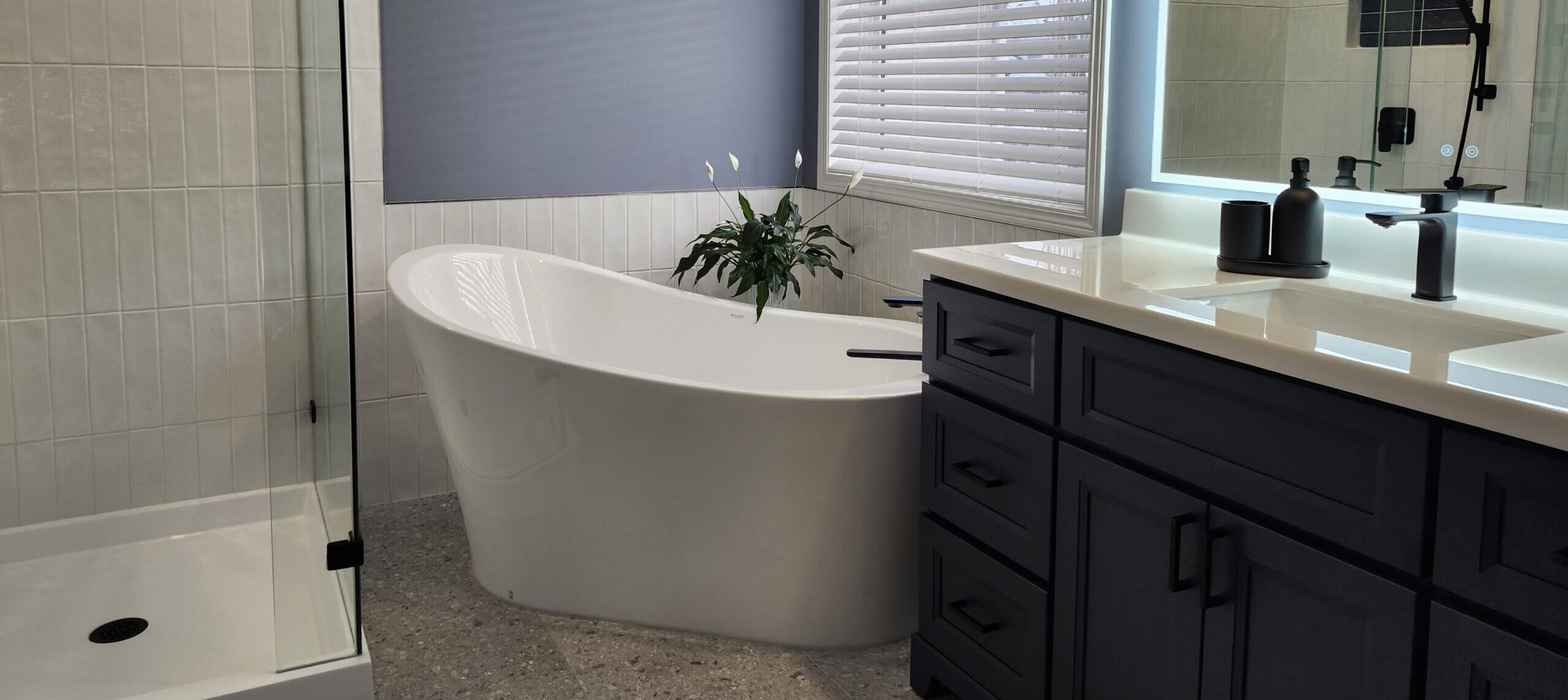
We always begin with one critical choice: the shape of your vanity top. This single design element shapes how your bathroom feels every day. On the other hand, not every shape will fit your space or match your routine.
For instance, a straight vanity top is ideal for narrow bathrooms where wall-to-wall functionality matters most. In contrast, curved edges or wave contours create a softer, more spacious impression. Therefore, we recommend assessing the way your bathroom is used and the spatial balance you need.
Moreover, vanity shapes like banjo or L-shaped configurations support corner or extended countertops. These allow you to expand counter space without making the room feel crowded. Above all, this decision directly affects how functional your mornings and evenings will be.
Sink choice does more than influence appearance. It redefines how convenient your entire routine becomes. In other words, your sink can either slow you down or streamline your habits.
An undermount sink is a sleek option that simplifies cleanup and highlights stone surfaces. However, vessel sinks add elegance and elevate the counter visually. Therefore, if you want something dramatic and eye-catching, a vessel style may suit you better.
For shared bathrooms or busy households, integrated bowl sinks offer seamless design and easier maintenance. Above all, think of who uses the sink daily and how. That alone should guide your decision more than any trend or aesthetic tip.
We often ask customers one simple question: do you need more separation or more surface? Your answer will guide you toward a single or double bowl sink setup. Meanwhile, think about your space and how often more than one person uses the area.
A single bowl is ideal for compact spaces or for people who want extra counter space. On the other hand, double bowls allow couples or roommates to share the sink without bumping elbows. That is to say, it adds convenience through separation.
Double sinks are especially popular in master bathrooms. But they do take more space and require careful faucet planning. In conclusion, it depends on whether you prioritize workflow or real estate on the countertop.
Material matters more than many homeowners realize. It doesn’t just affect the look, it transforms how long your setup lasts and how it wears. For example, some materials are more porous and show age faster.
Cultured marble is one of our favorites because of its customizable form and resilience. Likewise, engineered stone offers strength and a high-end appearance without the cost of quarried marble. Consequently, both provide great value and long-term satisfaction.
We suggest looking at how you clean and how much wear your vanity sees. In addition, consider how hot tools or sharp items could affect your surface. These practical habits will reveal which surface material suits you best.
Shape and location work together to determine flow. That is to say, even the most beautiful vanity top can feel out of place if installed awkwardly. After that, users start to feel cramped or awkward without realizing why.
If your bathroom layout includes alcoves or partial walls, a custom-cut shape can maximize usage. For instance, rounded corners near a doorframe reduce bumping risks. Meanwhile, floating vanity setups open visual space below the sink area.
Corner units are another creative way to use underutilized space. In short, vanity top shape isn’t just about appearance. It’s a tool that helps your bathroom feel more open and perform more effectively.
We’ve found that splash guards make a huge difference. Most importantly, they preserve your walls and improve daily upkeep. Therefore, if you’re tired of water damage or cleanup around your faucet, integrated guards are worth considering.
To clarify, splash guards are molded into the vanity top, eliminating seams where grime builds up. Similarly, side guards help in shared bathrooms or tight spaces where splashing is more frequent. Above all, they make your surfaces more forgiving.
Some styles allow you to include tall rear or side guards without compromising the look. In conclusion, this detail gives you both function and refinement. It’s subtle but transforms the daily experience.
When you’re redesigning your vanity, don’t ignore the tub. In other words, your vanity and tub should feel like part of a complete idea. We suggest matching tones, edges, or finishes to create harmony in the space.
For example, deep soaker tubs with angular profiles look best beside geometric counters. Likewise, curved tubs pair naturally with rounded vanity edges. Consequently, this kind of visual rhythm enhances the overall bathroom feel.
You can find elegant models that complement your layout through a curated range of custom bathtubs. If you’re searching for seamless inspiration, we recommend browsing high-performance bathtub options for coordinated styles.
Sometimes the best solution isn’t off-the-shelf. As a result, we provide options that let you decide on every detail. That is to say, from sink spacing to edge bevels, customization makes your vision possible.
You might need extra-deep counters, curved corners, or unusual faucet positions. Likewise, a custom vanity top helps work around vents, pipes, or architectural features. In addition, every bathroom has its own quirks, and your vanity should fit them.
We’ve seen clients transform narrow powder rooms and spa-style retreats alike. To sum up, a tailored fit provides both function and flair. If you’re ready to explore your configuration, just contact us.
Choosing your vanity isn’t just a solo task. It often comes alongside flooring, lighting, and wall finishes. Similarly, your sink style might affect faucet placement or cabinet choices.
We recommend starting with a visual map of your top priorities. After that, explore one upgrade at a time, beginning with the vanity. Consequently, you’ll avoid overwhelm and ensure every piece supports the whole.
If you want to see which combinations flow best, see more details about materials and design. In short, there’s no perfect formula, but there’s always a layout that feels right for you.
Curved or straight-edged tops are ideal for small bathrooms. They help reduce visual bulk and allow better movement. In other words, they fit tighter layouts without feeling cramped.
Yes, a vessel sink may require more attention around the base. However, it also adds height and visual interest. Therefore, the choice depends on whether ease or design is your priority.
It depends on the exact width and plumbing layout. Some narrow counters allow for closely spaced double sinks. But, single bowl setups are often better suited for tight spaces.
Integrated splash guards protect your walls and reduce cleaning efforts. That is to say, they’re molded into the vanity surface, so there are no gaps or seams where water can seep in.
They don’t need to match exactly. However, coordinating finishes or shapes creates a unified look. In conclusion, pairing similar elements brings harmony to your bathroom design.

* Excluding Long Weekends